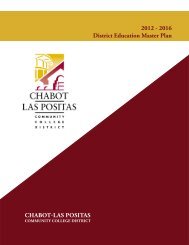City College of San Francisco - California Competes
City College of San Francisco - California Competes
City College of San Francisco - California Competes
Create successful ePaper yourself
Turn your PDF publications into a flip-book with our unique Google optimized e-Paper software.
THEME III<br />
• DACUM (Designing A CurriculUM) sessions involving seven faculty from five departments<br />
and over 12 representatives from industry, resulting in a summary <strong>of</strong> findings.<br />
• A two-day retreat attended by seven faculty and administrators to review and discuss research findings<br />
that had been provided by a project consultant, and determine implications for course finalization.<br />
The Design Collaborative team has effectively developed and obtained Curriculum Committee approval<br />
for three initial courses since the 2003–04 academic year: Design Fundamentals, Rapid Visualization, and<br />
Color in Design. Faculty members began testing two <strong>of</strong> these courses during the Spring 2004 semester.<br />
The collaboration has involved several faculty who have met to discuss the syllabi and classroom activities.<br />
The Color in Design course debuted in Spring 2005, and a Design History course will be ready for Fall<br />
2005, resources permitting. The next goal is to fully develop the Associate <strong>of</strong> Arts Degree in Design,<br />
which will entail more dialogs for developing the final two courses, Orientation to Design and the Design<br />
Practicum. This project, driven by faculty committed to dialog and finding ways to improve the learning<br />
experience for students, appears to be on its way to success.<br />
Enhanced Self-Study – Institution-Wide Dialog. The Enhanced Self-Study illustrates perhaps the most<br />
intensive, broad-based, informed, and intentional institutional dialog in the <strong>College</strong>’s history. Following<br />
the 2000 WASC Self-Study, the Chancellor proposed that the <strong>College</strong> undertake an Enhanced Self-Study<br />
Project (ESS) to “reach deeply and incisively into the critical areas <strong>of</strong> the <strong>College</strong> where students are served<br />
and success is achieved, to discover what we are doing that works and what is needed, and to recommend<br />
the various vital changes which, taken together, can transform this educational enterprise” (Opening Day<br />
Address, Fall 2000). His proposal was elaborated in the form <strong>of</strong> a handbook and disseminated to various<br />
individuals and groups, including the Academic Senate Executive Council and the Department Chairs<br />
Council for review and comments. After much debate and discussion among the <strong>of</strong>ficers <strong>of</strong> the Academic<br />
Senate, some revisions to the proposal were made and the project moved forward.<br />
In Fall 2000, members <strong>of</strong> the <strong>College</strong> community began organizing and meeting. From the beginning<br />
the goal was to use the <strong>College</strong> Shared Governance System to ensure the broadest involvement <strong>of</strong> the<br />
community. The basic structure <strong>of</strong> the ESS rested on five ad hoc committees: Pre-Registration and<br />
Matriculation; Pre-<strong>College</strong> Learning; <strong>College</strong> Level Learning; Enrollment Management Tools; and Student<br />
Outcomes. Orientation sessions were attended by more than 125 faculty, staff, students, and administrators<br />
during the fall semester, and these volunteers joined one <strong>of</strong> the five ad hoc committees. Initial<br />
meetings involved a lot <strong>of</strong> brainstorming and frank discussions about problems and concerns that<br />
committee members believed to be barriers to student learning and success. When a committee finally<br />
drafted a recommendation, the co-chairs brought that recommendation to the Ad Hoc Coordinating<br />
Council (AHCC) for more discussion and acceptance, if appropriate.<br />
The co-chairs <strong>of</strong> the five committees regularly provided progress reports to the AHCC, co-chaired by the<br />
Chancellor and the President <strong>of</strong> the Academic Senate, and composed <strong>of</strong> the co-chairs <strong>of</strong> the committees,<br />
the Vice Chancellors, a Department Chairs Council representative, and an Associated Students representative.<br />
The sessions consisted <strong>of</strong> co-chair updates and presentations <strong>of</strong> recommendations coming out <strong>of</strong> the<br />
committees. After more discussion and questioning from the AHCC, the co-chair(s) took the recommendation(s)<br />
back to their committees for further work before resubmitting them. During this interactive<br />
discussion process with the AHCC, two recommendations were merged, three others were not approved,<br />
and the AHCC discovered that two original recommendations could be readily implemented without<br />
being a part <strong>of</strong> the ESS recommendations.<br />
CITY COLLEGE OF SAN FRANCISCO<br />
285







